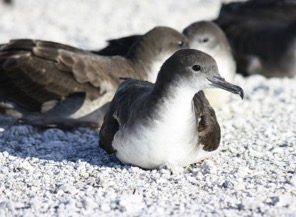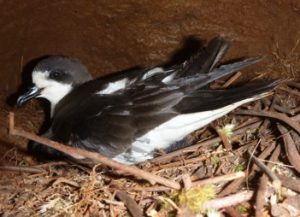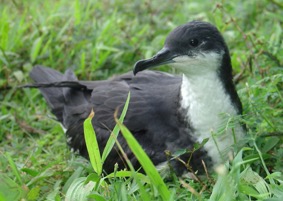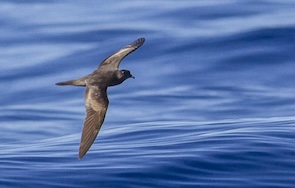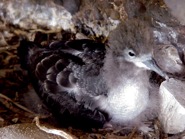Seabird Fallout Season
Seabird fallout season happens every year, roughly September 15 – December 15. You can help! Click here if you are currently responding to a seabird in potential need of rescue
What is Seabird Fallout?
Fallout is a phenomenon primarily affecting young seabirds (petrels and shearwaters) that leave their nest for the first time, and can also affect adults any time of year. Seabirds use natural lighting from the moon and stars to navigate out to sea where they spend their time feeding. They can become disoriented by our artificial lighting (lights in homes, businesses, street lights, etc.) and either circle lights or collide with structures, and may fall to the ground due to exhaustion or injury from collision. Once on the ground, they become extremely vulnerable to predators or may be hit by vehicles. During September through December, when young birds make their first flight out to sea, they are most at risk.
Which species are affected by this phenomenon?
Many seabird species on our islands can be affected by lighting. These are the species you are most likely to encounter:
|
‘Ua‘u kani, wedge-tailed shearwater (PC: A. Siddiqi) |
‘Ua‘u, Hawaiian petrel (PC: A. Raine) |
‘A‘o, Newell’s shearwater (PC: B. Zaun) |
ʻOu, Bulwer’s petrel (PC: Jacob Drucker) |
You can help by reducing light attraction at your home:
- Turn off unnecessary outdoor lights, especially between September 15 and December 15.
- Replace fixtures that scatter light in all directions with directional fixtures that point down and away from the beach. See examples of seabird-friendly lighting here.
- Shield light sources. Materials such as aluminum flashing can be used to direct light where it is needed.
- Use low-intensity lighting. For example, replace white incandescent, fluorescent, and high-intensity lighting with a maximum 40-watt yellow bug light.
- Use lights with minimal short wave length (400-500nm) content. Warm lights are best 1800-2200 Kelvin.
- If you have large windows, draw drapes at night to keep interior lights from distracting the birds.
If you are a pet owner, you can also help by keeping pets indoors or on leashes. Both cats and dogs can kill our ground-nesting seabirds.
What to do if you find a downed seabird?
On Friday 11/15/2024, the Hawaiʻi Department of Agriculture announced they had confirmed the H5N1 strain in birds from a backyard flock in Central Oʻahu. Human illness from H5N1 is uncommon, and people in Hawaiʻi are still unlikely to get sick from avian influenza at this time. Even though the risk of human transmission is low, it’s important to take extra precautions when handling birds. To report multiple or unusual illnesses in poultry, livestock, or other wild birds or animals, contact Hawaiʻi Department of Agriculture (HDOA) Animal Industry Division at 808-483-7100, Monday to Friday from 7:45 a.m. to 4:30 p.m., or 808-837-8092 during non-business hours and holidays, or email [email protected]. If you find a downed seabird and decide to rescue it, you can follow recommendations and information provided by the State Department of Health and guidance from the Centers of Disease Control. Practice proper hygiene and sanitize hands, clothes, towels and other items after handling any animal.
You can report downed seabirds using the contact list for wildlife centers below. If you believe the bird is injured or in an unsafe environment, you may consider assisting the bird with a rescue dropoff. Use caution and careful consideration before attempting to approach or transport a seabird. First, determine if it needs to be rescued: often young birds stay near their nest burrows and do not need intervention. These birds do not need to be rescued and must be left alone. If you are uncertain of whether the bird needs help, please contact a wildlife center on your island. The Division of Forestry and Wildlife, Hawaii Wildlife Center, or Kauaʻi Save Our Shearwaters groups can assist you with any questions. If a bird is found unresponsive or in an unsafe environment (i.e. side of the road, next to a building, etc.), it needs to be rescued.
|
A young wedge-tailed shearwater in front of burrow (PC: L. Young) |
An adult wedge-tailed shearwater in front of burrow (PC: L. Young) |
If you have determined the bird needs to be rescued, you can follow the steps below to get the bird to appropriate care.
- Find and prepare an appropriately sized, well-ventilated (with air holes) box or carrier
- Place a clean, soft cloth (e.g. a towel or t-shirt) on the bottom of the carrier.
- With caution, approach the bird from behind and use gloves or a lightweight towel to gently pick up the bird from behind, keeping the wings closed by the body, and place it in the carrier.
- Place the carrier in a quiet and dark place, away from people, animals, and loud noises.
- Do not give food or water to the bird and do not leave any in the container.
- Call the designated contact on your island for instructions. If your Island has designated drop-off locations, transport the bird to the closest one. Island-specific contact information for licensed rehabbers is provided below. Birds can be held for a few hours or overnight if transportation to a drop-off location (or pickup from the list of island-specific contacts) is not immediately available. Keep the carrier inside or in an enclosed garage away from people and animals until it can be transported.
- Complete our Fallout Response Information Form so the Division of Forestry and Wildlife is notified of the transported bird. You will need to provide contact information in case follow-up is required, along with information including date/time you found the bird, location of drop-off, and box number (if a bird is placed in a box at a designated drop-off site).
- After you drop off a bird, it will be evaluated and released in a suitable habitat if it is assessed to be healthy. Birds needing further treatment will be rehabilitated until ready for release. The public’s support of our downed seabird programs is crucial to their success. Your willingness to recover downed birds and follow established protocols is much appreciated!
Downed Wildlife Contacts: Who do I call on my island?
Contact information for each island is provided below in case you find a downed seabird or other native bird in need of help. Please use the specific numbers for your island. If you are unable to reach someone immediately, leave a message and keep the bird in a well-ventilated box in a dark, cool, quiet location with no food or water. Your call will be returned as soon as possible. Calls after hours may receive responses the following morning.
KAUAʻI
Type of Facility |
Species |
Organization |
Primary Contact |
|
State |
All native species |
Kaua‘i Division of Forestry and Wildlife (DOFAW) |
(808) 274- 3433 (808) 645- 1576 |
|
Licensed rehabber, see website for drop off locations |
All native species |
Save Our Shearwaters: (808) 635- 5117 |
OʻAHU
Oʻahu Downed Wildlife Drop-Off Information
| Type of Facility | Hours of Operation | Species | Organization/Location | Primary Contact |
| Drop off location | 24 hours, 7 days/week | Seabirds and waterbirds |
Feather and Fur Animal Hospital 25 Kaneohe Bay Dr #132, Kailua, HI 96734 |
(808) 254-1548 |
Oʻahu Downed Wildlife Rescue & Response
| Licensed rehabber & Rescue and Response | 9:00 am – 5:00 pm, 7 days a week | All native species | Hawai‘i Wildlife Center | (808) 884- 5000, [email protected] |
| Permitted volunteer group | 24 hours, 7 days a week | Manu-o-Kū | Hui Manu-o-Kū | Manu-o-Ku Hotline: (808) 379-7555 |
| Rescue & Response | 7:00am – 7:00pm, 7 days a week | Seabirds | Hawaii Marine Animal Response | 808-220-7802 |
Oʻahu Wildlife Inquiries or Questions
| State | 6:00 am – 4:00 pm M-F | All native species | O‘ahu Division of Forestry and Wildlife (DOFAW) | (808) 973-9778 (808) 587-0400 |
MAUI
| Type of facility | Species | Organization | Primary contact |
| State of Hawaii | Seabirds | Maui Division of Forestry and Wildlife (DOFAW) |
(808) 573-BIRD (2473) (808) 359-0403 |
| State of Hawaii | Nene and bats | Maui Division of Forestry and Wildlife (DOFAW) |
(808) 359-0624 (808) 870-6344 |
| State of Hawaii | All other native birds | Maui Division of Forestry and Wildlife (DOFAW) |
(808) 984-8100 during business hours (808) 870-6344 after business hours |
MOLOKAʻI
| Type of facility | Species | Organization | Primary contact |
| Licensed rehabber | Waterbirds, shorebirds | Arleone Dibben-Young | |
| State of Hawaii | All other native species | Molokai Division of Forestry and Wildlife (DOFAW) |
(808) 553-1745 (808) 870-7598 |
LĀNAʻI
| Type of facility | Species | Organization | Primary contact |
| State of Hawaii | All native species | Lanai Division of Forestry and Wildlife |
(808) 565-7916 (808) 357-5090 |
| Licensed rehabber | All native species | Hawaii Wildlife Center |
(808) 884-5000 (808) 563-0013 |
HAWAIʻI ISLAND
Type of Facility |
Species |
Organization |
Primary Contact |
|
State |
All native species |
East Hawai‘i Division of Forestry and Wildlife (DOFAW) |
(808) 974- 4221 808-974-4232 |
|
State |
All native species |
West Hawai‘i Division of Forestry and Wildlife (DOFAW) |
(808) 887- 6063 (808) 339- 0983 |
|
Licensed rehabber |
All native species |
(808) 884- 5000 |

